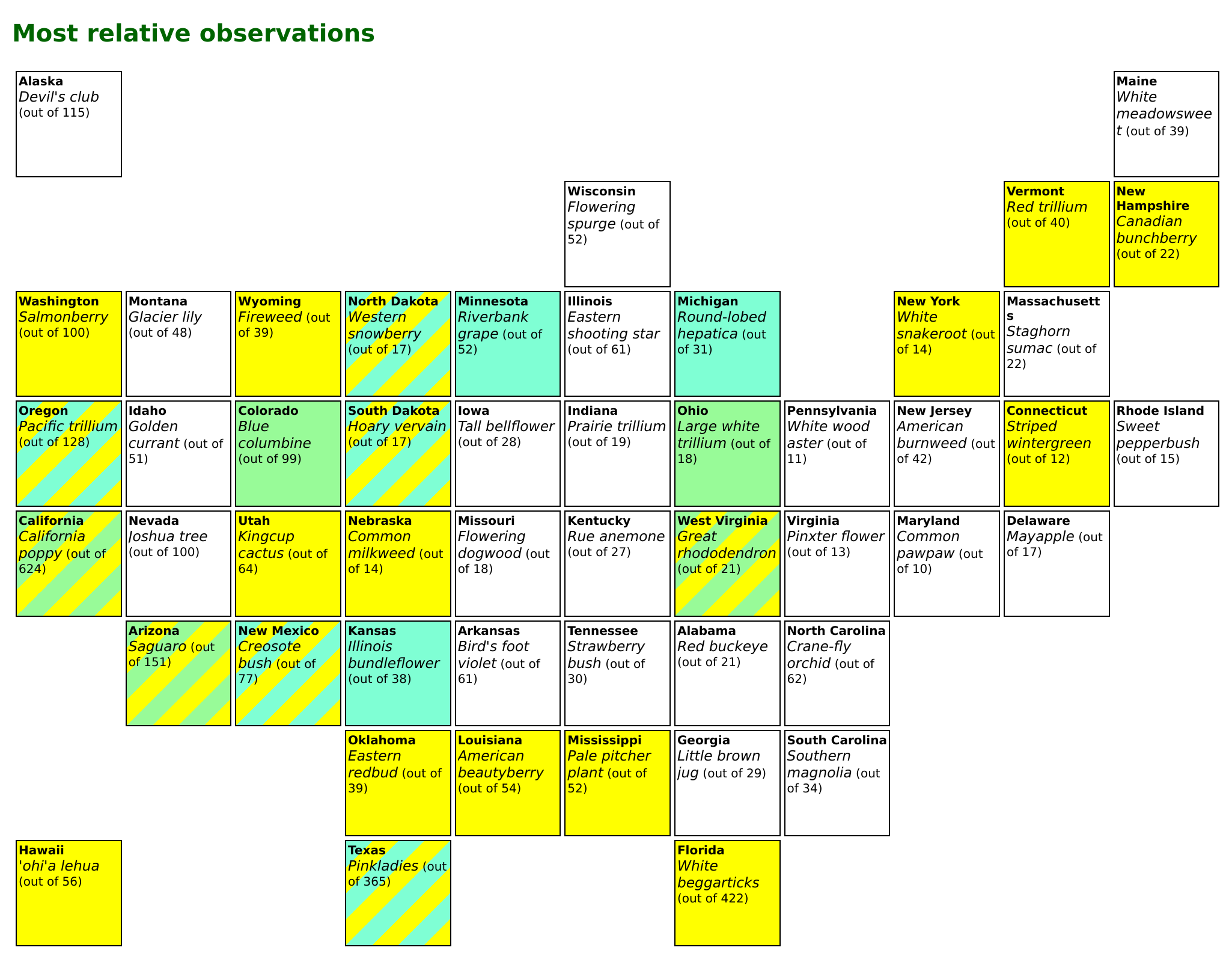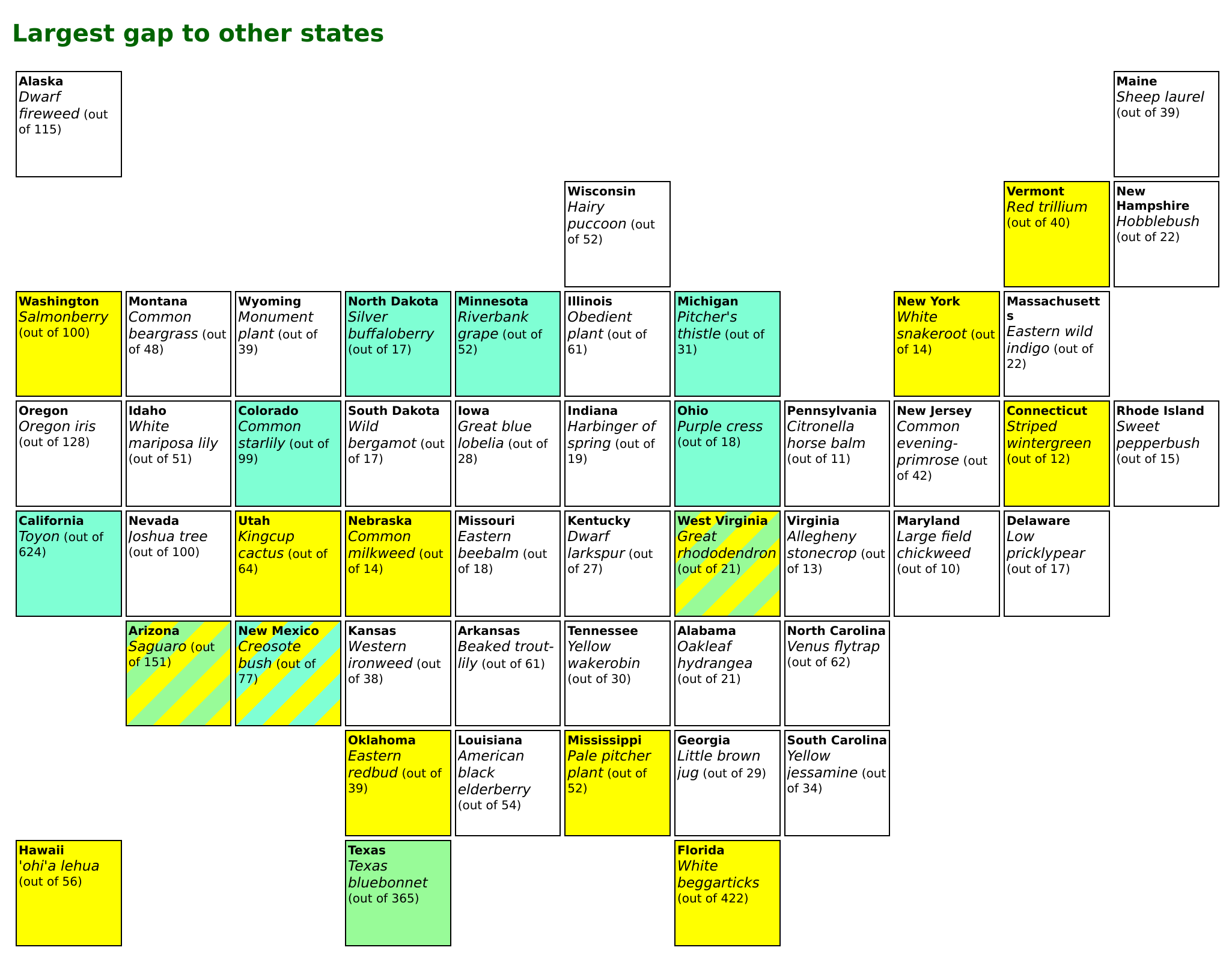What should your state's state-flower be?
Recently I saw a map of what each state's bird should be by Sam Allen and thought I could use the same technique for state flowers.
This is what the current official state flower is for each state (from Wikipedia):

Some states more recently added a "state wildflower" in addition to the "state flower", for example Ohio's state flower has always been the carnation, which is not even native. So at some point they decided to have large white trillium as the "state wildflower" - a much better choice and what I used above.
The highlighted in pink states are the ones which do not have a unique flower. It's only 12 states, and the following flowers were picked by more than one: Coreopsis, goldenrod, mountain laurel, prairie rose, violet. Some states did not exactly pick a flower, for example Maine has a tree, white pine. Which is a vascular plant but not a flowering plant. Some chose the flowers of a fruit tree like peach or another introduced species like red clover or peony. Some have an actual species like Minnesota's showy lady slipper or New Hampshire's pink lady slipper which are rare orchids. Some just use an entire genus like Coreopsis for Mississippi and Florida.
I decided to only use inaturalist observations as my data source, and only research-grade observations of native flowering plant species (sorry white pine and red clover and peony). I also excluded plants with less than 100 observations, as well as a set of wind pollinated flowers (so no American beech or big bluestem even though they are commonly observed). And I excluded poison ivy and poison oak which are among the most observed flowers. It shows the general problem with using observation counts - just because something is observed a lot doesn't mean it's liked a lot. Also, using the "native" filter in inaturalist is problematic as not everything has its native distribution filled in yet, but my hope was that it should cover all those often observed species in the US at least and it would keep all the introduced species off the list. Either way, as a first pass I assigned the most observed flower to each state:

Four states (green background) are particularly interesting here as the most observed plant on inaturalist is in fact their official state flower: Arizona, California, Illinois, West Virginia. Really have to commend Illinois for picking milkweed as state wildflower in 2017. For another ten states (blueish background) the official state flower is in the top 10 most observed flowers. 31 states share their state flower with another state.
To avoid the duplicate assignments I added another pass and now for each state select the flower where the state has the most relative observations out of all states. For example in Mississippi the pale pitcher plant makes up 2.76% of all observations. This is the most compared to any other state - in Louisiana only 1.61% of observations are of the pale pitcher plant. Each state happens to have several flowers where it has the most observations - California in fact has a whole 624 such flowers, while Pennsylvania and Maryland have only 11 each.

For 21 states this makes no difference to using the flower with the most observations and Arizona, California and West Virginia still use their official state flower just like before. However this time in addition to those also Colorado and Ohio get their official state flower assigned, the beautiful blue columbine and the large white trillium, respectively. Illinois now gets switched away from its state flower - while common milkweed is the most observed flower in Illinois, the just as cool Eastern shooting star boasts the most relative observations compared to other states, even though it is only the 24th most observed species. But each of the more often observed 23 flowers in Illinois have more relative observations in one of the other states. 9 states would still have the official state flower in their top 10 picks with this algorithm - that is the state flower is indeed a flower which has the highest percentage of observations in that state, we just picked another one.
Personally I quite like this map, but when following Sam Allen's argument for his bird map - the assigned flowers are not truly unique to the state. For example Ohio gets its state flower large white trillium assigned which makes up 1.78% of observations in the state. But in Michigan large white trillium also makes up 1.67% of observations, only slightly less. (In fact when including non-research-grade observations Michigan would have more relative observations.) In this example the gap in observations between Ohio and Michigan is 1.78%-1.67%=0.11%. However looking at all the observed species in Ohio, purple cress only makes up 0.55% of observations but the gap to other states is 0.17%. So in a way purple cress observations are more unique to Ohio than large white trillium. What would the map look like if we pick the flower for each state where it has the largest such gap to any other state?

Arizona and West Virginia still use the official state flower as always. And interestingly, Texas now joins them. Maybe some Texas officials have come up with this same algorithm before? California, Colorado and Ohio switch away from their state flowers as they have other flowers more uniquely observed in them. California in fact picks Toyon which isn't found in any other state (just in Mexico). Colorado now picks the common starlily which is also a beautiful plant, but certainly not as iconic as the blue columbine. Worse with Ohio, instead of the trillium it now gets purple cress which is a pretty spring wildflower but grows everywhere. For 13 states the assigned flower is still the same as with using the most observed one. California, Colorado, Michigan, Minnesota, New Mexico, North Dakota and Ohio still would have their state flower in their top 10 picks.
What does all this tell us? I don't really know! But it's clear that Arizona, California, Colorado, Connecticut, Illinois, Kansas, Michigan, Minnesota, New Hampshire, New Mexico, North Dakota, Ohio, Oregon, South Dakota, Tennessee, Texas, Utah and West Virginia chose a flower that can be backed up by inaturalist observations. The absolutely uncontested state flowers must be Saguaro for Arizona and Great Rhododendron for West Virginia, every single measure confirms them.
You can see the actual data I used here.





Comments
Add a Comment